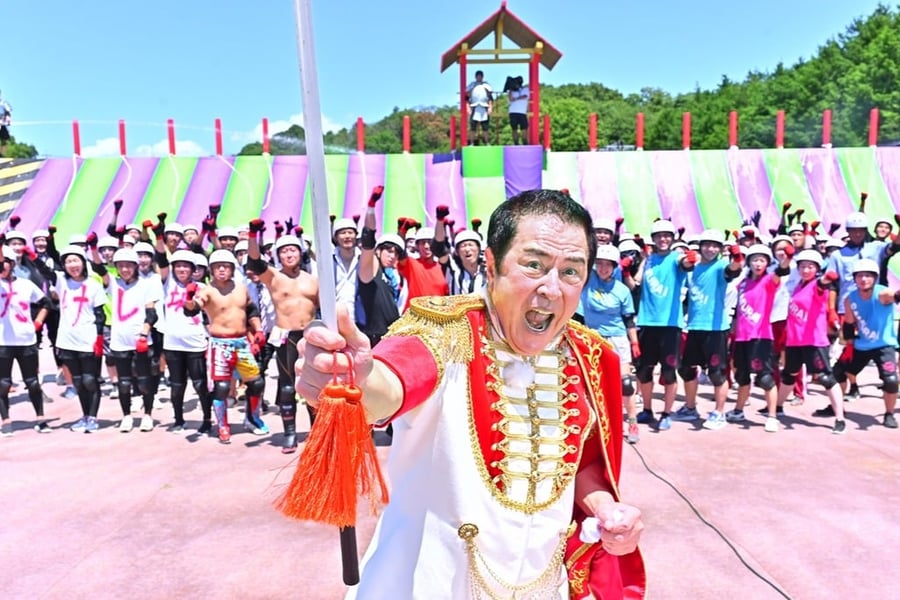In collaboration with Monsutā, Japanese Icons brings you the biggest stories from the birthplace of Monsutā’s lineup of drinks, Japan. Winning the coveted title of Japan’s Best International Lager in 2022, and recently launching a range of alcoholic lemon, mango and pineapple chūhais, Monsutā, along with its iconic Sumo, is a brand that symbolises and celebrates the best of Japan. From music to film, sports to gaming, this series celebrates the Japanese Icons that share the Monsutā legacy.
A lot of good things came out of the Japanese bubble economy in the late 80s and early 90s. The Game Boy, the Discman, city pop, but if absurdist humour and schadenfreude are your thing, perhaps none are more consistently entertaining than Japanese game show Takeshi’s Castle. Despite its fairly limited run on Japanese TV, the original series spawned countless international renditions and, with a recent online reboot, is continuing to win over new audiences even today.
With the tech boom taking off in Japan in 1985, so too did the popularity of television game shows and variety shows. This prompted Tokyo Broadcasting System and popular comedian and actor Takeshi Kitano (Battle Royale) to join forces to come up with a new concept. Inspired by the release of the Super Mario Bros. video game earlier in the year, Takeshi wondered what it would be like to have a game show that operated like a real-life video game. Setting to work on what TBS would promote as “the largest construction project of the 20th century,” producers spent roughly ¥100,000,000 (AU$1,024,518) constructing numerous elaborate obstacle courses at TBS studios in Midoriyama and Takeshi’s concept was brought to life as Takeshi’s Castle.
The concept saw up to 142 contestants per episode, led by General Tani, make their way through a series of physical challenges from rolling logs to rope swings and pole vaults, being slowly eliminated until the final few made it to the last round. The final challenge pitted the remaining contestants against Count Takeshi and his guards in an attempt to win ¥1,000,000, a feat only achieved eight times in 127 episodes. With further prizes being awarded for fighting spirit, contestants would earnestly and brazenly throw themselves into every challenge for a chance to stay in the game.
With the end of the show’s original run on Japanese television in 1990, Takeshi’s Castle would storm its way onto television screens in international adaptations, earning a massive following over the next few decades. The UK iteration would prove one of the most popular internationally, with actor and comedian Craig Charles (Red Dwarf) providing hilarious comedy to a condensed format of the show. Screening on British free-to-air TV, the program dominated its channel’s ratings for around two years, prompting Charles to coin the term “Keshi Heads” for the show’s avid fans and spawning numerous revivals and reboots in the decades following.
With physical challenge shows like Wipeout, Ninja Warrior, Ultimate Beastmaster and Netflix’s Squid Game: The Challenge gaining popularity in recent years, it is hard to deny the impact that “Takeshi’s Castle” continues to have on contemporary popular culture.
After a 34-year absence, Takeshi’s Castle made a triumphant return to screens with a reboot in April 2023, with Count Takeshi and General Tani even making appearances. Returning to Midoriyama Studios, the reboot features many of the fan-favourite games from the original series and its success proves the universal and timeless appeal of absurd, good-natured fun and watching people fall in mud.
Love Music?
Get your daily dose of everything happening in Australian/New Zealand music and globally.
From giant slams to giant-sized taste, Monsutā will be back with another Japanese Icon in a couple of weeks. Until then, head to BWS, Dan Murphy’s and Jimmy Brings and enjoy a taste of Japan in a can with Monsutās lineup of drinks.



































